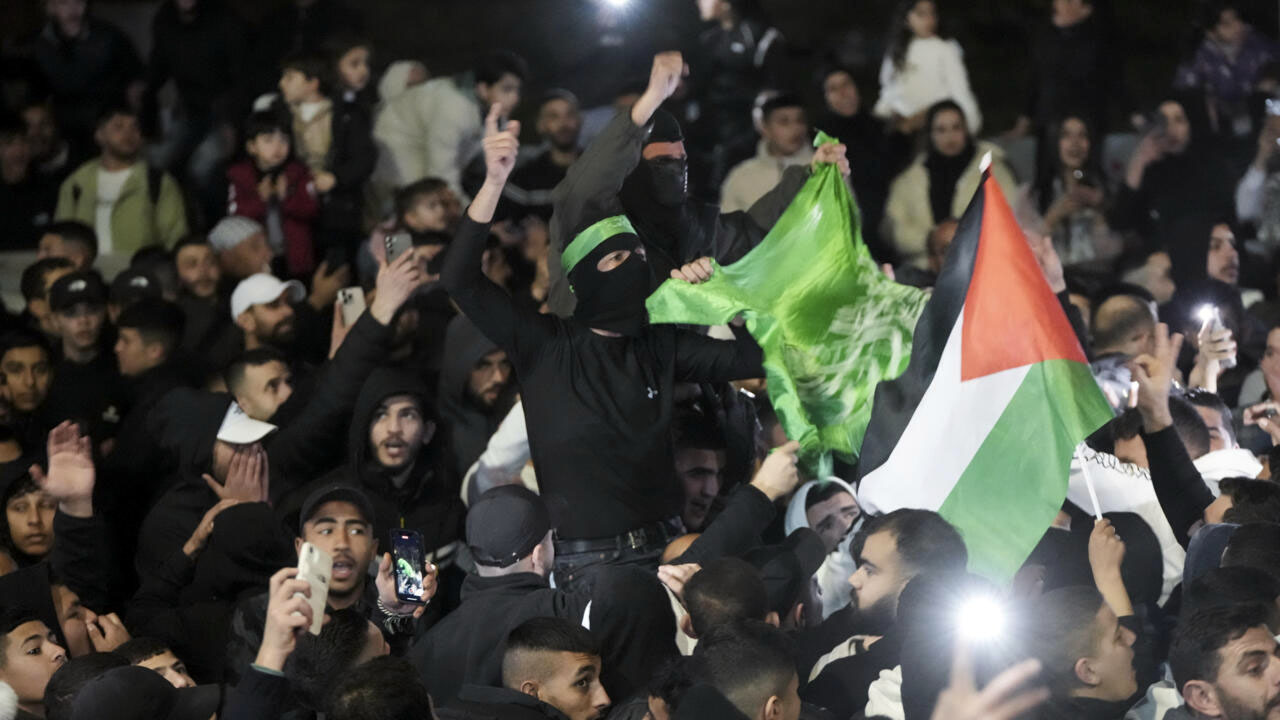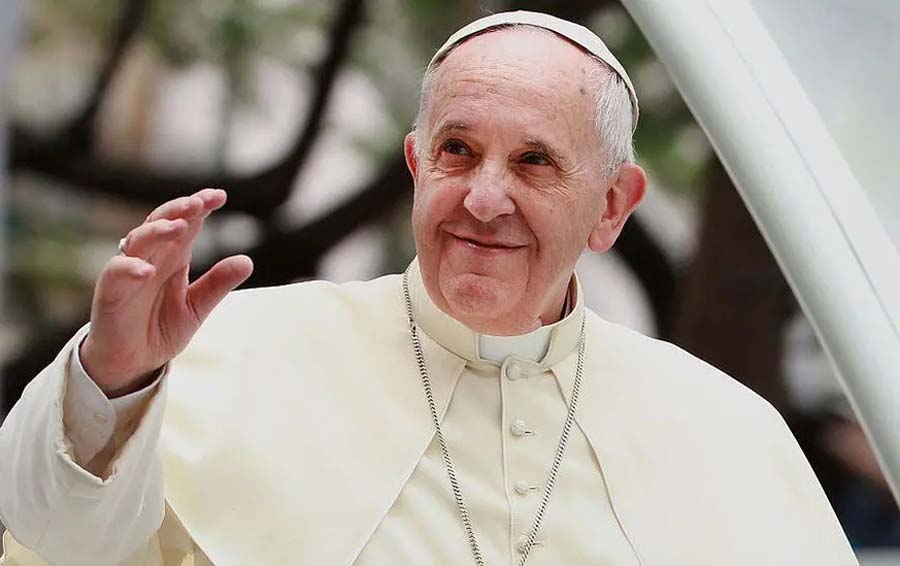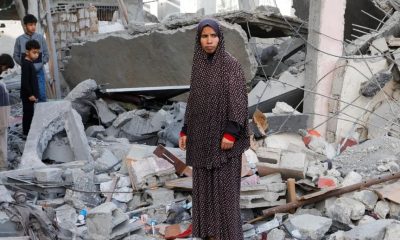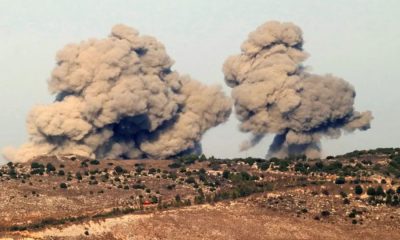International
Israel releases Palestinian prisoners after hostages freed

Israel releases Palestinian prisoners after hostages freed
JERUSALEM: A freed ex-militant received a hero’s welcome in the occupied West Bank on Thursday after chaos during a Gaza hostage release briefly delayed the third Israel-Hamas exchange under a ceasefire deal.
At around dusk, two buses carrying released inmates left from the West Bank’s Ofer Prison after Israel said it had received assurances from mediators over the future “safe release” of captives.
Hundreds of joyous Palestinians greeted them when they arrived in Ramallah, an AFP correspondent said.
Flashing a victory sign, the first to disembark was Zakaria Zubeidi, 49, a former top militant leader jailed for attacks that killed several Israelis.
The cheering crowd immediately hoisted him onto their shoulders.
Israel’s prison service confirmed it had freed 110 inmates in the latest hostage-prisoner swap under the January 19 ceasefire deal aimed at ending the war in Gaza.
Earlier in the day, after more than 15 months of captivity, three Israelis were freed by militants in Gaza alongside five Thais who were also captured in Hamas’s October 7, 2023 attack on Israel.
READ ALSO:
- 5,000 repentant Boko Haram fighters reunited with families –FG
- Naira rises to N1,493/$ in official market
- Corps members to start receiving N77,000 monthly allowance February — NYSC DG
Netanyahu had denounced what he called “shocking scenes” during the hostage releases in Khan Yunis, where television images showed gunmen struggling to control hundreds of Gazans seeking to witness the handover.
First to be freed Thursday was 20-year-old Israeli soldier Agam Berger, who was handed over to officials from the International Committee of the Red Cross (ICRC) in Jabalia, northern Gaza.
Before her release, footage showed her on a stage with masked Hamas members in distinctive green headbands, being prompted to wave to onlookers.
The Red Cross said it facilitated the latest hostage-prisoner exchange but urged all parties to improve security and uphold agreements.
“The security of these operations must be assured, and we urge for improvements in the future,” ICRC president Mirjana Spoljaric said in a statement.
Another hostage and prisoner release is scheduled for Saturday, with three Israeli men set to be freed.
All the freed Israeli and Thai hostages were taken to hospitals after their return to Israel, the military said.
The two other freed Israelis are civilians Gadi Moses, 80, and Arbel Yehud, 29, both of whom also hold German nationality.
Yehud’s family, still awaiting the release of her partner and brother from Gaza, urged future releases to go ahead unhindered.
“We urge everyone not to let this open door close. Everyone must be brought home immediately so that we can heal as a society,” the family said.
Footage released by the Israeli military showed Moses, 80, in the tearful embrace of his family during their reunion at a reception center in southern Israel.
READ ALSO:
- Obasa: DSS releases detained Lagos lawmakers after colleagues storm office
- Masked impact: How low storytelling limits Nigeria’s insurance industry growth
- Why Mohbad held secret wedding – Mum
Netanyahu’s office named the freed Thais as Watchara Sriaoun, Pongsak Tanna, Sathian Suwannakham, Surasak Lamnau and Bannawat Saethao.
“It is confirmed everyone, my son did not die. Thank you, God,” a sobbing Wiwwaeo Sriaoun said at her home in rural Thailand as she heard confirmation her farm worker son was among those freed.
In war-devastated Khan Yunis, dense crowds gathered to catch a glimpse of Yehud and Moses near the childhood home of Hamas leader Yahya Sinwar, who Israel killed in October.
On August 1, Israel’s military had announced the killing of the Hamas military chief, Mohammed Deif, but Hamas had never confirmed his death — until a statement from the group on Thursday announced his “martyrdom.”
The ceasefire hinges on the release of Israeli hostages taken during Hamas’s 2023 attack, in exchange for around 1,900 people — mostly Palestinians — in Israeli custody.
The truce deal has allowed a surge of aid into Gaza, where the war has created a long-running humanitarian crisis.
But Hamas accused Israel of slowing aid deliveries, with one official citing key items such as fuel, tents, heavy machinery and other equipment.
COGAT, the Israeli defense ministry body that oversees civilian affairs in the Palestinian territories, called this “totally fake news.”
As the text of the agreement — mediated by Qatar, Egypt and the United States — has not been made public, AFP was unable to verify its terms on aid.
The ceasefire deal is currently in its first, 42-day phase, which should see 33 hostages freed in stages, excluding the Thais.
Negotiations for a second phase of the deal should start next Monday, according to a timeline given earlier by an Israeli official. This phase would cover the release of the remaining captives, the Times of Israel has reported.
US President Donald Trump has repeatedly claimed credit for sealing the agreement, which took effect before his inauguration, and his Middle East envoy Steve Witkoff, who took part in the talks, met Netanyahu in Israel on Wednesday.
Trump has invited Netanyahu to the White House on February 4, according to the premier’s office.
More than 376,000 displaced Palestinians have gone back to northern Gaza since Israel reopened access this week, according to the UN humanitarian office OCHA, with many returning to little more than rubble.
“My house is destroyed,” 33-year-old Mohammed Al-Faleh told AFP.
“The biggest problem is that there is no water,” he added. “Food aid is reaching Gaza… but there is no gas or electricity. We bake bread on a fire fueled by wood and nylon.”
Israel cut ties with the UN agency for Palestinian refugees (UNRWA) from Thursday following accusations some of its staff belong to Hamas.
UNRWA has long been the lead agency in coordinating aid to Gaza, and the United Nations said on Thursday it would continue working in all Palestinian territories despite the Israeli legislation.
Israel releases Palestinian prisoners after hostages freed
ARAB NEWS
International
Thousands pay tributes as Pope Francis’ body lies in state at St. Peter’s Basilica

Thousands pay tributes as Pope Francis’ body lies in state at St. Peter’s Basilica
Vatican City was filled with the sounds of bells and heartfelt chants on Wednesday morning, as thousands of mourners gathered to honor the late Pope Francis.
In a moving and solemn procession, his simple wooden coffin was carried through St. Peter’s Square, marking the beginning of final rites for the beloved pontiff.
The procession began at the Domus Sancta Marta, the residence where Pope Francis passed away, and continued toward St. Peter’s Basilica. There, his body will lie in state until his funeral, scheduled for Saturday.
Two long lines of cardinals and Vatican officials escorted the coffin, while faithful from around the world looked on in prayer and reverence.
Dressed in a red chasuble and a white miter, with a rosary gently wrapped around his fingers, Pope Francis was honored with continuous applause as Swiss Guards solemnly accompanied the casket through the square.
Teresa Piuvano, a New Jersey resident who has been in Rome since March volunteering at Vatican events for the Jubilee year, saw Francis’ appearances on Palm Sunday and Easter Sunday. Easter, she said, “was the most special. I think he wanted to do that to say goodbye to the people because he rode around the whole square even though he was very ill.”
Inside the basilica, the pope was laid on a simple podium instead of the wooden structure, called a catafalque that has traditionally held a pope’s coffin as he lies in state. The ceremony that concluded the procession, led by Cardinal Kevin Farrell, who as camerlengo is charged with overseeing the logistics of the pope’s funeral, referred to Francis in humble terms such as “bishop” and “pastor.”
READ ALSO:
- Rivers: Tinubu set to emergency rule after meeting Fubara
- NNPCL: Protesters storm AGF office, demand probe of Mele Kyari
- Fresh herders’ attack claims 11 lives in Benue
“Dearest brothers and sisters, with great emotion we accompany the mortal remains of our Pope Francis into the Vatican basilica where he often exercised his ministry as the bishop of the church that is in Rome and as pastor of the universal church,” Farrell said in the prayer service.
After the death of Pope Emeritus Benedict XVI, Francis changed the protocol for papal funerals to streamline and simplify the procedures. The pope wanted his own funeral to reflect the life of a pastor and not of a powerful king or politician, he said in interviews.
After the ceremony, cardinals proceeded to bow one by one in front of the coffin before the mourners lined up in the square were admitted.
Nearly 20,000 people visited the basilica yesterday, according to the Vatican, which added that it would ensure that all who wish to pay their final respects to the pope have a chance by staying open after midnight if necessary.
Second General Congregation of Cardinals held in the Vatican
The second General Congregation of Cardinals began yesterday afternoon in the Synod Hall at about 5:00 PM, and ended at 6:30 PM.
According to the Holy See Press Office, 103 cardinals were present. They began the meeting with the ‘Veni, Sancte Spiritus’ prayer, and then with a prayer in suffrage of Pope Francis.
The Cardinals who were not present at Tuesday’s General Congregation were sworn in.
The programme of the Novemdiales, the ancient nine-day period of mourning for the Pope, was approved.
The next General Congregation will be today at 9:00 AM.
At the first General Congregation, held on Tuesday morning, the Cardinals decided to suspend all scheduled beatifications until the new Pope can approve them.
Moreover, in accordance with the norms of Universi Dominici Gregis, a commission of three Cardinals was selected by lot to assist the Camerlengo in the governance of the Church during the sede vacante.
These three Cardinals represent the three orders of the College of Cardinals and are replaced every three days. The first group of three Cardinals chosen was Pietro Parolin (episcopal order), Stanisław Ryłko (presbyteral order), and Fabio Baggio (diaconal order).
The Holy See Press Office noted that around 20,000 people had paid their respects to the late Pope Francis as of 7:30 PM on Wednesday evening.
Why King Charles isn’t allowed at pope’s funeral
Prince William will be traveling to the Vatican to attend the funeral of Pope Francis on behalf of the British royal family later this week. And if you’re wondering why King Charles isn’t going, he literally isn’t allowed.
Royal expert Katie Nicholl writes in Vanity Fair that King Charles “will not travel to the Vatican, in accordance with protocol and precedence which dictates that the Sovereign does not attend funerals, Buckingham Palace has confirmed.” And FYI, this isn’t the first time an heir has attended the funeral of a pope on behalf of the sovereign—back in 2005, then-Prince Charles attended Pope John Paul II’s funeral instead of Queen Elizabeth.
That said, King Charles did visit the pope just a few days before his recent passing, and he released a statement after his death.
Thousands pay tributes as Pope Francis’ body lies in state at St. Peter’s Basilica
International
UK records over 22,000 asylum-seeking Nigerians

UK records over 22,000 asylum-seeking Nigerians
The United Kingdom Home Office received 22,619 asylum petitions from Nigerian nationals between 2010 and 2024.
Nigerians accounted for one in every 30 UK asylum claims over the time, ranking 11th in the Home Office’s recently released year-end asylum and resettlement figures.
According to the Home Office, over two times as many Nigerians (2,841) requested asylum in 2024 than in 2023 (1,462).
Overall, 108,138 people applied for asylum in the UK in 2024, representing a 378 per cent increase from 2010. The majority were first-time claims by South Asian and Middle Eastern nationals.
Iran topped the chart with 75,737, perhaps pushed by the rising persecution of dissidents by the Iranian regime.
Pakistan trailed far behind with 57,621. In 2024, 10,542 Pakistanis sought asylum in the UK, prompted by post-election upheaval, rising inflation, and an increase in blasphemy cases, which human rights groups argue provide strong grounds for protection claims.
Afghanistan has received 54,363 asylum petitions since 2010. In 2024, 8,508 Afghans sought sanctuary in the United Kingdom, a development that experts suggest is a continuation of the Taliban’s ouster of the Karzai administration in 2022.
That year, 11,358 Afghans applied for asylum in the United Kingdom, with 9,710 applications the following year.
Others include Albania (50,944), Iraq (45,711), Eritrea (37,687), Syria (34,997), and Bangladesh (31,744). Asylum seekers from Bangladesh increased from 5,097 in 2023 to 7,225 in 2024. The rise corresponded with the removal of previous Prime Minister Sheikh Hasina.
READ ALSO:
- Driver crushes one-year old boy to death in Ekiti
- Bring your children to compete with mine, MC Oluomo challenges those mocking his spoken English
- Insecurity: Presidency questions push for state police, accuses govs of not doing much
Sudan and India complete the top ten, with 30,897 and 30,179, respectively.
Nigeria’s 22,619 filings are just ahead of Sri Lanka’s 22,059 and surpass Vietnam, China, and Turkey. Brazil, Kuwait, Yemen, Colombia, and Jordan were at the bottom of the list, with each providing fewer than 6,500 claims.
Analysts attribute Nigeria’s rise on the list to tough conditions such as insecurity, bandit assaults, abduction, and a collapse in household purchasing power following the naira’s devaluation in 2023.
In a conversation with our correspondent, Charles Onunaiju, Research Director, Centre for China Studies, Abuja, stated, “We face a difficulty. Nigeria is becoming unfriendly, particularly for young people with limited opportunities, and there is a desperate desire to travel overseas.
According to local reports, young professionals who previously entered the UK on skilled worker visas are increasingly hedging their bets by applying for asylum once there; others arrive irregularly via continental Europe, citing kidnapping threats and communal attacks in their affidavits.
According to the reports, in most cases, petitioners also claim political persecution under Nigeria’s wide cybercrime legislation or discrimination based on sexual orientation—both of which are protected under the Refugee Convention.
According to the Home Office’s website, an asylum seeker must demonstrate a “well-founded fear of persecution” because of their race, religion, nationality, political opinion, or membership in a certain social group.
The Home Office determines the initial decisions, and negative rulings can be challenged in the Immigration and Asylum Chamber.
In theory, the Illegal Migration Act of 2023 makes people who travel through a safe third nation inadmissible.
However, the UK government’s proposed removal process, particularly its contract with former Prime Minister Rishi Sunak to transfer claimants to Rwanda, is still enmeshed in legal obstacles.
As a result, the majority of 2024 and 2025 arrivals will continue to use the existing system.
Dr Aliyu Ilias, an Abuja-based development economist, told The PUNCH that as more Nigerians leave and stay permanently overseas, the country will have less trained labour.
He stated that with most Nigerians confronting both economic headwinds and deteriorating security at home, the British asylum route, however uncertain, still appears to offer a better prospect.
Ilias explained, “It’s definitely a cause of concern because this includes our professionals who are moving, and it takes a whole lot to train these professionals.
“In the medical sector, Nigeria subsidises a lot to get people trained. You cannot get trained as a medical doctor or an engineer abroad for a cheaper cost compared to what we get in Nigeria.
“So, it is total brain drain in the long run, and for the economy, it is reducing our GDP. The appalling part is that most of our Nigerian brothers and sisters who go out do not return. They get permanent residency, and they become valuable to the immediate country.”
UK records over 22,000 asylum-seeking Nigerians
International
Harvard University sues Trump over funding cuts

Harvard University sues Trump over funding cuts
Harvard sued US President Donald Trump’s administration Monday in a sharp escalation of the fight between the prestigious university and the Republican, who has threatened its funding and sought to impose outside political supervision.
Trump has sought to bring several prestigious universities to heel over claims they tolerated campus anti-Semitism, threatening their budgets, tax-exempt status and the enrolment of foreign students, but Harvard has refused to bow.
“This case involves the Government’s efforts to use the withholding of federal funding as leverage to gain control of academic decision making at Harvard,” the Ivy League university said in a lawsuit filed in a Massachusetts federal court that named several other institutions targeted by Trump.
“The Government’s actions flout not just the First Amendment, but also federal laws and regulations,” said the complaint, which called Trump’s actions “arbitrary and capricious.”
Trump is furious at Harvard for rejecting government supervision of its admissions, hiring practices and political slant and last week ordered the freezing of $2.2 billion in federal funding to the storied institution.
The lawsuit calls for the freezing of funds and conditions imposed on federal grants to be declared unlawful, as well as for the Trump administration to pay Harvard’s costs.
Trump and his White House team have publicly justified their campaign against universities as a reaction to what they say is uncontrolled “anti-Semitism” and a need to reverse diversity programs aimed at addressing historical oppression of minorities.
READ ALSO:
- NNPCL: Ojulari’s ambitious five-year $60bn investment agenda
- Osimhen to rake in N136bn from Man United
- U20 AFCON: Flying Eagles tackle Young Pharaohs in friendly
The administration claims protests against Israel’s war in Gaza that swept across US college campuses last year were rife with anti-Semitism.
Many US universities, including Harvard, cracked down on the protests over the allegations at the time, with the Cambridge-based institution placing 23 students on probation and denying degrees to 12 others, according to protest organizers.
“Harvard can no longer be considered even a decent place of learning, and should not be considered on any list of the World’s Great Universities or Colleges,” Trump said on his Truth Social platform last week.
“Harvard is a JOKE, teaches Hate and Stupidity, and should no longer receive Federal Funds.”
-

 metro2 days ago
metro2 days agoRivers: Tinubu meets with Fubara, may lift his suspension
-

 metro3 days ago
metro3 days agoBring your children to compete with mine, MC Oluomo challenges those mocking his spoken English
-

 metro2 days ago
metro2 days agoI’m not in supremacy battle with Ooni, says new Alaafin
-

 Business3 days ago
Business3 days agoMarketers count losses as NNPC slashes petrol price
-

 metro3 days ago
metro3 days agoRivers: Fubara’s supporters praise Tinubu’s intervention with emergency rule
-

 metro2 days ago
metro2 days agoBandits attack Kwara North, kill vigilante, six others
-

 Business2 days ago
Business2 days agoNigeria’s gas production increases by 15.6% to 227,931.65 mscf
-

 Entertainment19 hours ago
Entertainment19 hours agoP-Square: Jude Okoye freed after two months detention













